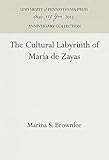The Cultural Labyrinth of María de Zayas / Marina S. Brownlee.
Material type: TextSeries: Anniversary CollectionPublisher: Philadelphia : University of Pennsylvania Press, [2000]Copyright date: ©2000Description: 1 online resource (232 p.)Content type:
TextSeries: Anniversary CollectionPublisher: Philadelphia : University of Pennsylvania Press, [2000]Copyright date: ©2000Description: 1 online resource (232 p.)Content type: - 9780812235371
- 9781512807127
- 863 21
- PQ6498.Z5
- online - DeGruyter
- Issued also in print.
| Item type | Current library | Call number | URL | Status | Notes | Barcode | |
|---|---|---|---|---|---|---|---|
 eBook
eBook
|
Biblioteca "Angelicum" Pont. Univ. S.Tommaso d'Aquino Nuvola online | online - DeGruyter (Browse shelf(Opens below)) | Online access | Not for loan (Accesso limitato) | Accesso per gli utenti autorizzati / Access for authorized users | (dgr)9781512807127 |
Browsing Biblioteca "Angelicum" Pont. Univ. S.Tommaso d'Aquino shelves, Shelving location: Nuvola online Close shelf browser (Hides shelf browser)

|

|

|

|

|

|

|
||
| online - DeGruyter Marionettes in the North of France / | online - DeGruyter The University of Pennsylvania Faculty : A Study in American Higher Education / | online - DeGruyter The Song in the Story : Lyric Insertions in French Narrative Fiction, 1200-1400 / | online - DeGruyter The Cultural Labyrinth of María de Zayas / | online - DeGruyter Sentimental Twain : Samuel Clemens in the Maze of Moral Philosophy / | online - DeGruyter Rise From Want : A Peasant Family in the Machine Age / | online - DeGruyter Exclusive Conversations : The Art of Interaction in Seventeenth-Century France / |
Frontmatter -- Contents -- Acknowledgments -- Preface -- 1. Spectacle and Surveillance: A Writing Woman in Seventeenth-Century Spain -- 2. Baroque Subjects: Changing Perspectives in Zayas's Novelas -- 3. Reading Magic: Mass Printing, Mass Audience -- 4. In the Labyrinth: Exemplary Excess -- Epilogue: Who Is Fabio? -- Notes -- Bibliography -- Index
restricted access online access with authorization star
http://purl.org/coar/access_right/c_16ec
A seventeenth-century writer of sensationalist short stories, María de Zayas was a bestselling author, steeped in the novella traditions of Italy and France as well as her native Spain. At the same time, she was an important player in the tabloid craze sweeping over the Europe of her day. Marina S. Brownlee recontextualizes María de Zayas and provides a reading of Zayas's work from the double perspective of narratology and feminism. In doing so Brownlee explores the complexities of human subjectivity and its representation in the writings of Zayas, who offers provocative assessments of the modern subject and its relationship to gender, and of the woman writer's negotiations with authority and authorship. Zayas's stories question the validity of hegemonic discourses pertaining to public expectations for the citizen, to his or her intimate life, and to the intricacies resulting from any attempt to reconcile the two. Her writing is both daring and original as it reflects developments in contemporary fiction elsewhere in Europe. Brownlee shows that Zayas exploits existing fiction models in highly literary ways and in ways that cash in on the new phenomenon of tabloid publishing, arguing that Zayas is keenly aware of the new readership that resulted from the mass-production revolution in the printing industry and of the private readers' taste for scandal. Finally, Zayas dramatizes the rethinking of the Renaissance exemplum, replacing easy interpretations with Baroque excess-in a text which, like society itself, is an intricate labyrinth that resists easy solutions and limited forms of literary and cultural representation.
Issued also in print.
Mode of access: Internet via World Wide Web.
In English.
Description based on online resource; title from PDF title page (publisher's Web site, viewed 24. Apr 2022)


